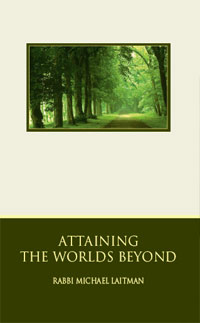Reward and Punishment in Spirituality
Human beings must unwillingly carry out all actions that are necessary to sustain physical life in the body. For example, even when we are ill and lack the desire to eat, we still force ourselves to take food, knowing that we will not become healthy otherwise. This is because, in our world, reward and punishment is clearly discernable for everyone; thus, all must obey the laws of nature.
But regardless of the fact that our souls are ill and can be cured only by performing altruistic efforts, when we are unable to see apparent rewards and punishments, we cannot force ourselves to undertake the process of healing.
Therefore, the healing of the soul is completely dependent on our faith.
The Process of Concealment and Revelation
The lower half of the Higher Spiritual Object is found within the upper half of the lower spiritual object. In the lower object, the screen (Masach) is found in the eye area. This is known as “spiritual blindness,” because in such a state only the lower half of the higher object is visible to us, since the screen of the lower spiritual object conceals part of the Higher Spiritual Object.
The Higher Spiritual Object drops its screen to the lower one, then it reveals itself to the lower object, which in turn begins to view the higher object as the higher one views itself. As a result, the lower object receives the state of fullness (Gadlut). The lower object, then, sees that the higher one is in a “great” state, and realizes that the higher object’s prior concealment and apparent manifestation as the “small” state (Katnut), was done exclusively for the benefit of the lower one. In this way, the lower object could become aware of the importance of the higher one.
How Egoistical Desires Transform to Their Opposite
All consecutive states that we experience on our paths can be compared to being inflicted by the Creator with an illness, which the Creator Himself eventually cures. When we perceive this illness (for example, as hopelessness, weakness, and despair) as the Will of the Creator, this transforms these states into the stages of correction and we can progress toward unity with the Creator.
As soon as the Light of the Creator enters an egoistical desire, that desire immediately submits to the Light and is ready to be transformed into altruism. (It has been said many times that Light cannot enter an egoistical desire, but there are two kinds of Light: the Light that comes to correct a desire, and the Light that brings pleasure; in this case we mean the Light that brings correction.)
Thus, when the Light enters these desires, they are changed into their opposites. In this manner, even our biggest sins are transformed into merits. But this occurs only if we return because of our love for the Creator, when we are able to receive the entire Light of the Creator not for our own sake.
Only then do our former actions (desires) become transformed into vessels that can receive Light.
Such a state cannot come about, however, prior to the final correction. Until then, we may receive only a part of the Creator’s Light, not for our own sakes, but according to the principle of the middle line.
The Forming of the Middle Line
There are several ways of receiving: by charity, by a gift, or by forcefully taking it (demanding because one is entitled). When one receives charity, one may be ashamed of it, but one still asks from necessity. On the other hand, one does not ask for a gift. Rather, a gift is given to one who is loved. One who demands does not consider having received either as charity or as a gift, but by right.
This latter feeling is characteristic of the righteous who demand of the Creator, thinking that they are entitled to something intended for them in the very design of creation. Thus, it is said: “The righteous take by force.”
Abraham (the right line: faith above reason) was ready to sacrifice Yitzhak (the left line: reason and control of one’s spiritual condition) in order to constantly progress only along the right line. Consequently, he advanced to the middle line, which combines the two.
Simple faith is an uncontrolled faith and is usually known as “faith below reason.” Faith that is checked by reason is known as “faith within reason.” But faith above reason is possible only after one has analyzed one’s state.
Thus, if we, seeing that we accomplished nothing, still chose faith as if everything had been accomplished, and continued to uphold this belief up to the critical point, then this is considered to be “faith above reason,” because we had ignored reason. Only then do we become worthy of the middle line.
 “Reason, Faith, and the Creator’s Revelation” is based on the book, Attaining the Worlds Beyond by Dr. Michael Laitman.
“Reason, Faith, and the Creator’s Revelation” is based on the book, Attaining the Worlds Beyond by Dr. Michael Laitman.

